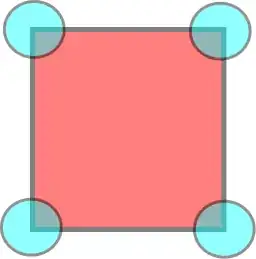Question:
Consider a hypercube $C := \{\vec{x}\in\mathbb{R}^n : \forall(i)\: |x_i|\leq 1\}$ and hypersphere $S_r := \{\vec{x}\in\mathbb{R}^n : |\vec{x}| = r\}$. Let $R(n)$ be the radius of the sphere for which the intersection $C\cap S_{R(n)}$ has maximal area. What is the asymptotic behavior of $R(n)$ as $n\rightarrow \infty$?
Background:
For an n dimensional ball, the mass on a shell of radius $r$ grows like $r^{n-1}$ right up to the boundary of the ball. Knowing where the mass is located on a high dimensional object is useful for e.g. statistical mechanics.
By comparison to the ball case, you might expect that the mass of a cube would also be near the farthest extremity, which for the case of $C$, above, would be at the vertices, distance $\sqrt{n}$ from the center. However, there is an argument why there is not much mass near the vertices: Consider centering little balls on each of the vertices and looking at the volume of the intersection of the balls with the cube (see figure). Each ball intersects the cube only in a sector of $1/2^n$ of the ball, and there are $2^n$ vertices, so the total volume of the balls' intersections is just the volume of one ball. Thus there is the same volume in a neighborhood of the vertices as there is in a neighborhood of the center of the cube (or any other interior point)!
Hence the above question: What shell of the cube has the most mass? It's easy to see that $1<R(n)<\sqrt{n}$. Can you do better?
